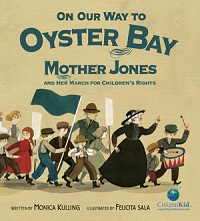| ________________
CM . . .
. Volume XXIII Number 3. . . .September 23, 2016
excerpt:
We regularly witness the media’s accounts of protest rallies and marches. Often, participants include children who will no doubt be affected by the issues being highlighted. How much do they understand? This picture book, part of a series called “CitizenKid”, shines the spotlight on the longstanding concern of child labour. Specifically, it presents one event in early 20th century American history: an attempt to bring attention to the plight of young children employed in Pennsylvania cotton mills. Youngsters like Aidan and Gussie were forced to work gruelling hours in dangerous conditions for low pay, and they were denied the chance to attend school. Based on the actual 1903 march led by labour activist Mary Harris “Mother” Jones, the story describes the two-week trek that succeeded in arousing public attention about the need for new child labour laws, even though it failed in its immediate objective of a meeting with President Roosevelt. Through eight-year-old Aidan’s viewpoint, the reader is drawn into the details that prompted a workers’ strike. The energetic character of Mother Jones sweeps both workers and the reader along, describing the day-to-day life of the marchers and how she keeps their spirits up, feeds and shelters them and even arranges a train ride for part of the journey. All the while, she spreads the word about their cause with speeches in public parks and on street corners. A day of fun at Coney Island offers an opportunity to contrast the lives of the working children with those of more affluent families. Finally, Mother Jones helps the children consider how the march achieved awareness and delivers the story’s message about the need to stand up for what’s right, even if change isn’t immediately evident. The illustrator has created basic representative settings, peopled with collage-style characters of the children, as well as the various citizens encountered along the way. She has portrayed the granny-like figure of Mother Jones in an authentic way as a diminutive but commanding activist who vigorously took up the role as pied piper on the historic march. At the conclusion of On Our Way to Oyster Bay, the author has included background information about the key elements of the book: the real Mother Jones, child labour, contemporary examples of young people who have spoken out against child labour around the globe, and ways the reader can learn more. The picture book format is a fine way to make issues such as child labour accessible to a young audience. Introducing the story of someone fighting for social justice in this non-violent way will kindle awareness and inspire discussion. Greater empathy and deeper understanding of the past gives young people the tools to deal with the present (in which child labor still exists) and future. Highly Recommended. Gillian Richardson is a freelance writer living in BC.
To comment
on this title or this review, send mail to cm@umanitoba.ca.
Copyright © the Manitoba Library Association. Reproduction for personal
use is permitted only if this copyright notice is maintained. Any
other reproduction is prohibited without permission.
Next Review | Table of Contents For This Issue - September 23, 2016 |
